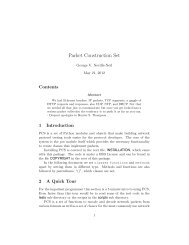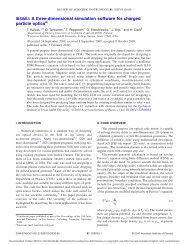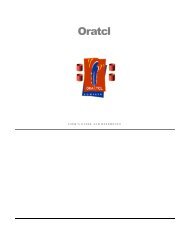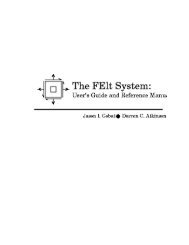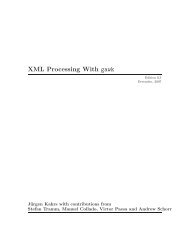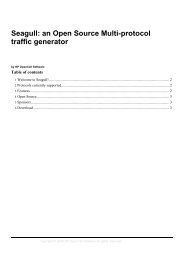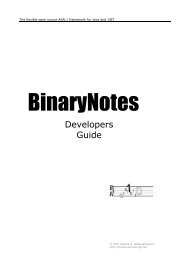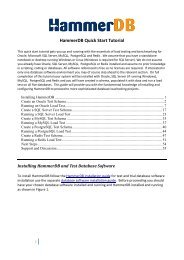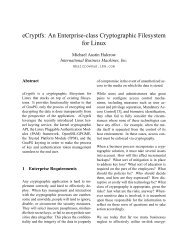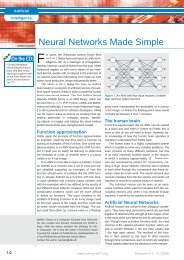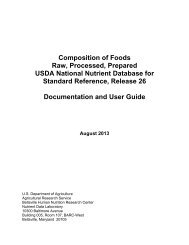System Management Bus (SMBus) Specification, version 2.
System Management Bus (SMBus) Specification, version 2.
System Management Bus (SMBus) Specification, version 2.
You also want an ePaper? Increase the reach of your titles
YUMPU automatically turns print PDFs into web optimized ePapers that Google loves.
<strong>System</strong> <strong>Management</strong> <strong>Bus</strong> (SM<strong>Bus</strong>) <strong>Specification</strong> Version <strong>2.</strong>0<br />
5.5.9 SM<strong>Bus</strong> host notify protocol<br />
To prevent messages coming to the SM<strong>Bus</strong> host controller from unknown devices in unknown formats only<br />
one method of communication is allowed, a modified form of the Write Word protocol. The standard<br />
Write Word protocol is modified by replacing the command code with the alerting device’s address. This<br />
protocol MUST be used when an SM<strong>Bus</strong> device becomes a master in order to communicate with the<br />
SM<strong>Bus</strong> host acting as a slave.<br />
Communication from SM<strong>Bus</strong> Device to SM<strong>Bus</strong> Host begins with the SM<strong>Bus</strong> Host address (0001 000b).<br />
The message’s Command Code is the initiating SM<strong>Bus</strong> device’s address. From this, the SM<strong>Bus</strong> Host<br />
knows the origin of the following 16 bits of device status. The contents of the status are device specific.<br />
1 7 1 1 8 1 8 1 8 1 1<br />
S SMB Host Addr. Wr A Device Address A Data Byte Low A Data Byte High A P<br />
Master (SM<strong>Bus</strong> Device) to Slave<br />
Slave (SM<strong>Bus</strong> Host) to Master<br />
Figure 5-23: 7-bit Addressable Device to Host Communication<br />
SM<strong>Bus</strong> hosts must support the host notify protocol. Hosts may implement the optional #SMBALERT line<br />
if devices in the system use it.<br />
5.6. SM<strong>Bus</strong> Address resolution protocol<br />
SM<strong>Bus</strong> slave address conflicts can be resolved by dynamically assigning a new unique address to each<br />
slave device. The Address Resolution Protocol (ARP) possesses the following attributes:<br />
• Address assignment utilizes the standard SM<strong>Bus</strong> physical layer arbitration mechanism<br />
• Assigned addresses remain constant while device power is applied; address retention through device<br />
power loss is also allowed<br />
• No additional SM<strong>Bus</strong> packet overhead is incurred after address assignment. (i.e. subsequent accesses<br />
to assigned slave addresses have the same overhead as accesses to fixed address devices.)<br />
• Any SM<strong>Bus</strong> master can enumerate the bus<br />
5.6.1. Unique Device Identifier (UDID)<br />
In order to provide a mechanism to isolate each device for the purpose of address assignment each device<br />
must implement a unique device identifier (UDID). This 128-bit number is comprised of the following<br />
fields:<br />
8<br />
bits<br />
Device<br />
Capabilities<br />
Msb<br />
8<br />
bits<br />
Version /<br />
Revision<br />
16<br />
bits<br />
16<br />
bits<br />
16<br />
bits<br />
16<br />
bits<br />
Vendor ID Device ID Interface Subsystem<br />
Vendor ID<br />
16<br />
bits<br />
Subsystem<br />
Device ID<br />
32<br />
bits<br />
Vendor<br />
Specific ID<br />
Lsb<br />
Figure 5-24: UDID<br />
Device Capabilities<br />
Describes the device’s capabilities. See detail below.<br />
SBS Implementers Forum 34



